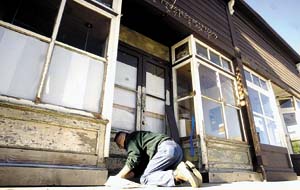
San Juan Bautista
The decision facing San Juan Bautista voters Nov. 6 could be bigger than a sales tax or a growth cap. The election, some officials say, could determine whether the Mission City will remain a city at all.
California Assemblywoman Anna Caballero, who represents San Benito County and part of Monterey County, said she has examined San Juan Bautista’s budget and things aren’t looking good.
“They’re struggling economically, and in the short term, there’s no relief in sight,” Caballero said. “They do not have revenue on an annual basis to provide the services.”
Officials have complained about dwindling revenue, leading to the elimination of city landscaping, a cutback on code enforcement and the reduction of hours at City Hall and the library. The city has also lost a $3.8 million grant from the federal Economic Development Administration to fund construction of its water infrastructure project.
So the question before voters, Caballero said, is whether they want to continue paying the greater expense needed to enjoy city-level services.
“The residents are really in a position to decide whether they want to continue to be a city,” she said.
Caballero added that she hopes San Juan can continue to be a city, but added: “It really is up to San Juan Bautista. What I think is not important.”
Can San Juan Bautista really stop being a city? It can, through a process called disincorporation. And not everyone is against it. Former City Councilman Chuck Geiger, for example, said it’s time for the citizens to vote on whether they want the city’s existence to continue.
“It’s obvious that the citizens are extremely disappointed in the City Council’s mismanagement resulting in the termination of the EDA grant,” Geiger said. “In addition, the City Council has dismantled the Historical Resource Board. … In my opinion, it is time for a vote.”
There are also safety reasons for San Juan Bautista to return to unincorporated San Benito County, Geiger said, particularly in light of the city fire department’s difficulties recruiting new volunteers.
“We can’t be sitting there thinking each little community is going to take care of itself,” he said.
City Manager Jan McClintock said November’s ballot initiatives both would help the Mission City’s finances, suffering from a drop in sales tax dollars and a lack of growth in property taxes. If the measures fail, she said the city’s existence could be called into question.
“What’s going to happen is that we’re going to have to continually cut services,” McClintock said.
And if that goes far enough, she said locals would start wondering if there’s any reason for San Juan Bautista to remain a city. McClintock and others said residents calling for disincorporation don’t realize how little control they would have over their town.
“What they would lose is that self-determination,” said County Supervisor Anthony Botelho, whose district includes San Juan Bautista. “That’s why you have cities.”
City Councilman Rick Edge also noted that San Juan Bautista has only 1,800 residents, while San Benito County has more than 50,000.
“If the city has to disincorporate, I don’t know if the 1,800 people realize that they will not have much say in what goes on,” he said.
San Benito County already includes several unincorporated communities, such as Tres Pinos. In the midst of the community’s recent debate over the construction of the Spur Hotel, hotel opponent Jamie Frusetta said she and her neighbors recently realized how frustrating it can be when decisions with a local impact are made at the county level.
Frusetta said some Tres Pinos residents have started to talk themselves about the possibility of becoming an incorporated city.
“With the whole hotel thing, that was really upsetting,” she said. “When an important decision gets made, it should be made by people who live in the town.”
Disincorporating a city is incredibly rare, said William Chiat, executive director of California Association of Local Agency Formation Commissions. It happened only once in recent state history, when the City of Cabazon, population 613, disincorporated in 1972.
According to a Riverside County LAFCO staff report, citizens voted to disincorporate because of “the present inadequacies of fire and police protection and the general instability of local government.”
During the two years prior to disincorporation, 15 people served on the five-member City Council, including six as mayor, according to the staff report, and Cabazon averaged four or five recall elections per year. In addition, the city had only three police officers, including the chief, and the chief had been suspended by the council.
The details of disincorporation would be determined by the San Benito County LAFCO, Chiat said, but the city would have to apply to the county LAFCO, and its citizens would probably have to vote on disincorporation.
“It’s not a simple process,” Chiat said. “It’s expensive, it’s complex. … In this day and age, disincorporating would be pretty extreme.”
Anthony Ha covers local government for the Free Lance. Reach him at 831-637-5566 ext. 330 or ah*@***********ws.com.









